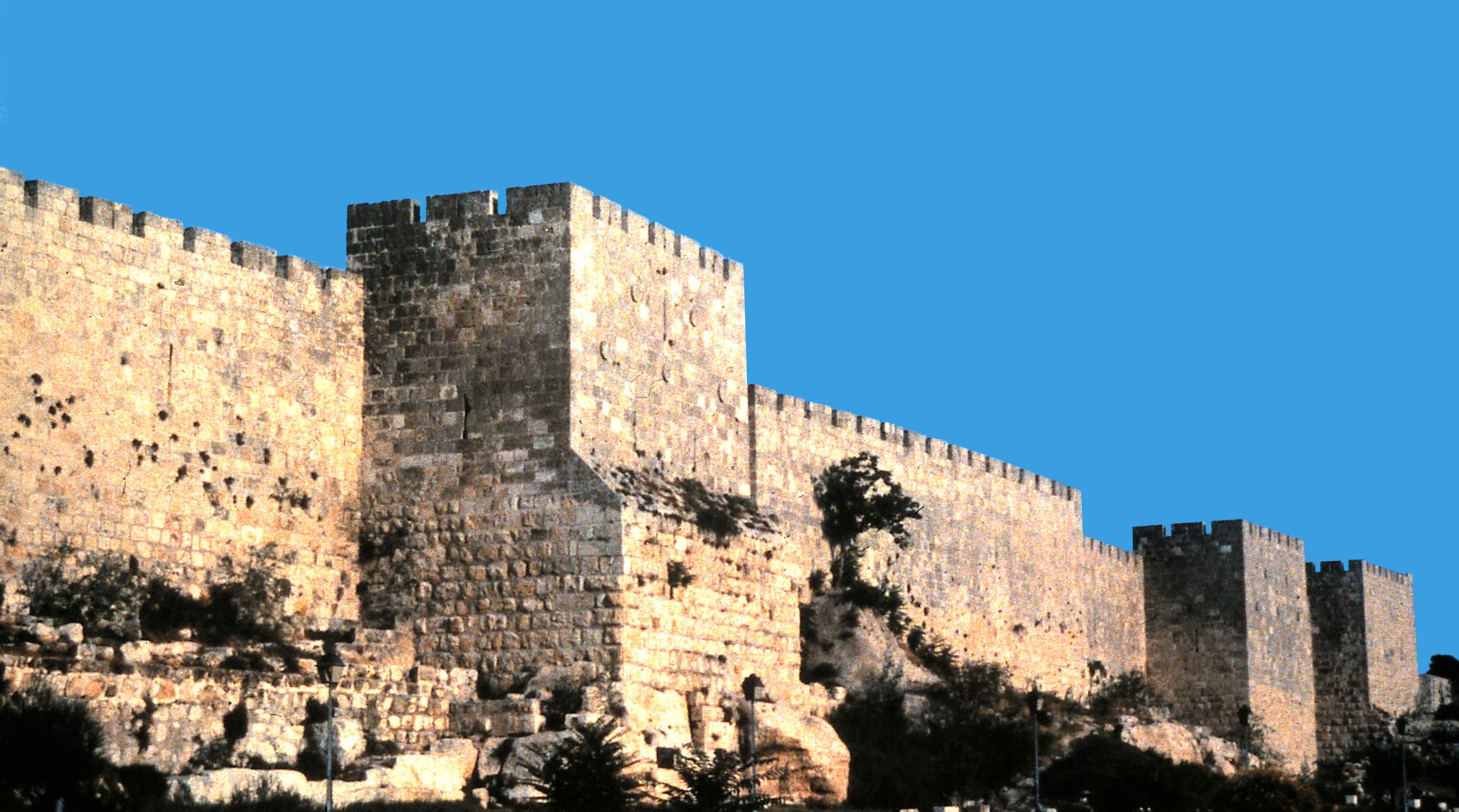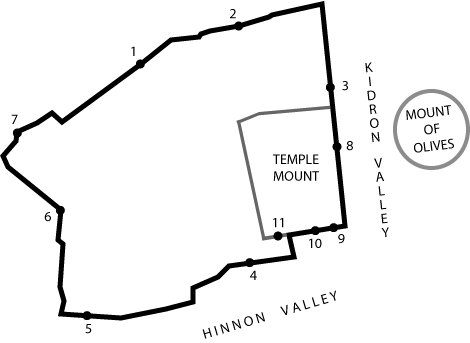THE GATES OF JERUSALEM
In the spirit, he carried me to the top of a very high mountain, and showed me Jerusalem, the holy city, coming down out of heaven from God. It had all the glory of God and glittered like some precious jewel of crystal-clear diamond. Its wall was of a great height and had twelve gates... (Revelation 21:10-12a).
 The 16th Century wall of Jerusalem
The 16th Century wall of Jerusalem
The sandstone walls of the Old City of Jerusalem are known for their spectacular rosy-golden glow as the sun rises at dawn, and they exhibit the same beauty in the last hours of daylight just prior to sunset. The present city wall was constructed in 1538 AD by the Ottoman ruler Suleiman the Magnificent above the ruins of the old 1st century walls that stood when Jesus lived. Over the centuries since the 16th century wall was built, eleven gates have guarded the entrances to the nearly three-mile long fortified perimeter of the Old City of Jerusalem and to the most sacred area of the city, Jerusalem's Temple Mount. Today only seven of these gates are opened:
Four of old Jerusalem's gates are no longer open:
|

|
The four gates whose entry arches are bricked in are all found along the southern and eastern walls of the Temple Mount. The Temple Mount is the elevation upon which the Jerusalem Temple once stood. Today that area is occupied by the 7th century AD Moslem shrine known as the Dome of the Rock and by the Al-Aqsa Mosque. Not all the gates date from the eras of the ancient city. The Single Gate was built by the Crusaders in the 12th century AD to provide access to the underground area of the Temple Mount which the Crusaders named "Solomon's Stables." The New Gate was opened in the northwestern corner of the Old City in 1887 AD to allow access for pilgrims and Church officials to the Christian Quarter of the old city. The Double and Triple Huldah Gates were originally built by King Herod during the Second Temple period and were named after the 7th century BC prophetess (2 Kg 22:14-20; 2 Ch 34:22-28). These gates were located inside the city walls until the Crusader period when part of the wall was demolished, and they were incorporated into the surviving walls of the city. The Huldah Gates were built to give direct access to the Jerusalem Temple precincts through underground passages. The Crusader's Single Gate and the Double and Triple Huldah Gates were walled-up in 1187 AD after Moslem General Saladin's conquest of Jerusalem.
The most famous gate is the double-arched Golden Gate. This gate is located in the eastern wall of the Temple Mount directly across from the Kidron Valley and the Mount of Olives. The Golden Gate that existed in Jesus' time was the gate through which Jesus probably gained access to the city after visiting friends in the village of Bethany, on the Mount of Olives. It was the gate through which Jesus must have entered the city on Palm Sunday (John 12:12-15), the gate through which He probably exited the city the night of the Last Supper to pray in the Garden of Gethsemane (Mt 26:30, 36; Mk 14:26, 32; Lk 22:39; Jn 18:1), and the gate Jesus passed through forty days after His Resurrection (Acts 1:9) when His disciples accompanied Him to the Mount of Olives, the site from which He Ascended to Heaven (Acts 1:9-12).
After Jesus' Ascension, an angel told the Apostles and disciples that Jesus would return in the same way He left (Acts 1:11). Coupled with the messianic prophecy of Zechariah 14:4 that in the Day of Yahweh's Coming the Mount of Olives will be split in half from east to west, the Church Fathers professed the belief that when Jesus returns He will enter Jerusalem through the Golden Gate. It was to prevent the fulfillment of these messianic prophecies that Suleiman the Magnificent sealed the portals of the Golden Gate in 1541 AD, and the gate remains sealed to this day.
Click on the following for a picture of the following walled-up gates in the Jerusalem wall
In St. John's final vision in the Book of Revelation he saw that the new messianic Jerusalem of the new creation was to be a perfect square with three gates on each side of the city walls for a total of twelve gates: In the spirit, he carried me to the top of a very high mountain, and showed me Jerusalem, the holy city, coming down out of heaven from God. It had all the glory of God and glittered like some precious jewel of crystal-clear diamond. Its wall was of a great height and had twelve gates and there was an angel, and over the gates were written the names of the twelve tribes of Israel; on the east there were three gates, on the north three gates, on the south three gates, and on the west three gates. The city walls stood on twelve foundation stones, each one of which bore the name of one of the twelve apostles of the Lamb (Revelation 21:10-14). It is the vision of these gates of the New Jerusalem to which we must all aspire, and through the grace of God to have the privilege to enter.
| Open Gates | Constructed | Location in wall |
| 1. Damascus Gate | 1537 gate was built above 1st century AD gate | middle of northern side |
| 2. Herod's Gate | 16th century opening was enlarged in 1875 | east of northern side |
| 3. Lion's Gate | 1538-9 | north of eastern side |
| 4. Dung Gate | 1538-40 | east of southern side |
| 5. Zion's Gate | 1540 | west of southern side |
| 6. Jaffa Gate | Small 16th century opening; present gate was built next to old opening in 1898 | middle of western side |
| 7. New Gate | constructed in 1887 | west of northern side |
| Closed Gates | Constructed | Location in wall |
| 8. Golden Gate | 16th century gate built above the gate that existed in 1st century | east wall of Temple Mount |
| 9. Single Gate | 12th century Crusader gate gave access to areas beneath the Temple Mount | south wall of Temple Mount |
| 10. Triple (Huldah) Gate | Built during the reign of King Herod in the Second Temple period. | south wall of Temple Mount |
| 11. Double (Huldah) Gate | Built during the reign of King Herod and were inside the city wall giving access to the Temple precincts until the Crusader period. | south wall of Temple Mount |
Michal Hunt, Copyright © 2009 Agape Bible Study. Permissions All Rights Reserved.
